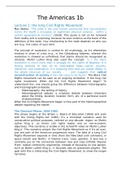College aantekeningen
College aantekeningen The Americas Ib (LAX026P05)
- Instelling
- Rijksuniversiteit Groningen (RuG)
Met deze samenvatting van hoor- en werkcolleges van The Americas 1b is de voldoende gegarandeerd binnen! In verhaalvorm in het Engels geschreven met veel details waardoor je niks mist. Dus, heb je eens een college gemist, wees dan niet getreurd en koop dit document!
[Meer zien]







